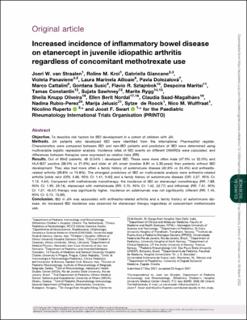| dc.contributor.author | van Straalen, Joeri W. | |
| dc.contributor.author | Krol, Roline | |
| dc.contributor.author | Giancane, Gabriella | |
| dc.contributor.author | Panaviene, Violeta | |
| dc.contributor.author | Ailioaie, Laura Marinela | |
| dc.contributor.author | Dolezalova, Pavla | |
| dc.contributor.author | Cattalini, Marco | |
| dc.contributor.author | Susic, Gordana | |
| dc.contributor.author | Sztajnbok, Flavio | |
| dc.contributor.author | Maritsi, Despoina | |
| dc.contributor.author | Constantin, Tamas | |
| dc.contributor.author | Sawhney, Sujata | |
| dc.contributor.author | Rygg, Marite | |
| dc.contributor.author | Oliveira, Sheila K. | |
| dc.contributor.author | Nordal, Ellen Berit | |
| dc.contributor.author | Saad-Magalhaes, C | |
| dc.contributor.author | Rubio-Perez, Nadina | |
| dc.contributor.author | Jelusic, Marija | |
| dc.contributor.author | de Roock, Sytze | |
| dc.contributor.author | Wulffraat, Nico | |
| dc.contributor.author | Ruperto, Nicolino | |
| dc.contributor.author | Swart, Joost Frans | |
| dc.contributor.author | International Trials Org, Paediatric Rheumatology | |
| dc.date.accessioned | 2022-09-09T11:22:12Z | |
| dc.date.available | 2022-09-09T11:22:12Z | |
| dc.date.created | 2022-03-07T23:18:34Z | |
| dc.date.issued | 2021 | |
| dc.identifier.issn | 1462-0324 | |
| dc.identifier.uri | https://hdl.handle.net/11250/3016881 | |
| dc.description.abstract | Objectives: To describe risk factors for inflammatory bowel disease (IBD) development in a cohort of children with juvenile idiopathic arthritis (JIA). Methods: JIA patients who developed IBD were identified from the international Pharmachild register. Characteristics were compared between IBD and non-IBD patients and predictors of IBD were determined using multivariable logistic regression analysis. Incidence rates of IBD events on different disease-modifying anti-rheumatic drugs (DMARDs) were calculated, differences between therapies were expressed as relative risks (RR). Results: Out of 8,942 patients, 48 (0.05%) developed IBD. These were more often male (47.9% vs 32.0%) and HLA-B27 positive (38.2% vs 21.0%) and older at JIA onset (median 8.94 vs 5.33 years) than patients without IBD development. They also had more often a family history of autoimmune disease (42.6% vs 24.4%) and enthesitis-related arthritis (ERA) (39.6% vs 10.8%). The strongest predictors of IBD on multivariable analysis were ERA (OR: 3.68, 95% CI: 1.41-9.40) and a family history of autoimmune disease (OR: 2.27, 95% CI: 1.12-4.54). Compared with methotrexate monotherapy, the incidence of IBD on etanercept monotherapy (RR: 7.69, 95% CI: 1.99-29.74), etanercept with methotrexate (RR: 5.70, 95% CI: 1.42-22.77) and infliximab (RR: 7.61, 95% CI: 1.27-45.57) therapy was significantly higher. Incidence on adalimumab was not significantly different (RR: 1.45, 95% CI: 0.15-13.89). Conclusion: IBD in JIA was associated with ERA and a family history of autoimmune disease. An increased IBD incidence was observed for etanercept therapy regardless of concomitant methotrexate use. | en_US |
| dc.language.iso | eng | en_US |
| dc.publisher | Oxford University Press | en_US |
| dc.rights | Navngivelse-Ikkekommersiell 4.0 Internasjonal | * |
| dc.rights.uri | http://creativecommons.org/licenses/by-nc/4.0/deed.no | * |
| dc.title | Increased incidence of inflammatory bowel disease on etanercept in juvenile idiopathic arthritis regardless of concomitant methotrexate use | en_US |
| dc.type | Peer reviewed | en_US |
| dc.type | Journal article | en_US |
| dc.description.version | publishedVersion | en_US |
| dc.source.journal | Rheumatology | en_US |
| dc.identifier.doi | 10.1093/rheumatology/keab678 | |
| dc.identifier.cristin | 2008190 | |
| cristin.ispublished | true | |
| cristin.fulltext | original | |
| cristin.qualitycode | 1 | |

